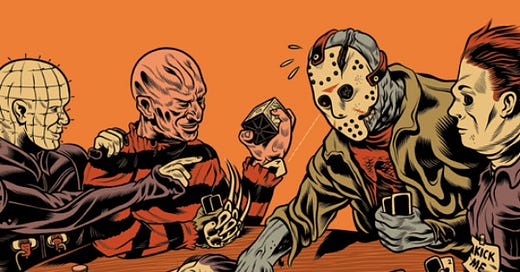Why Kids Love Horror

Admit it. When you roamed the aisles of the video store as a child, you always broke off from your parents to peruse the horror section. Scanning the sinister collection was like opening Pandora’s Box — and watching the films was a rite of passage.
I'm grown up now (for the most part) and oddly enough, these films make me feel like a kid again. I'm always reminded of the mystique they had during my childhood, their air of forbidden mystery.
Up until a few months ago, I had never seen the pillars of the horror genre, namely “The Texas Chainsaw Massacre,” “Friday the 13th,” “A Nightmare on Elm Street,” and “Hellraiser.” With my first year of college approaching, I was growing nostalgic for my childhood. So, over the summer, I decided to finally sit down and watch these films I had been anxiously awaiting all these years.
I wanted to unravel their veil of mystery, but I also wanted to discover why children are so drawn to these horror classics year after year, why they dress up as the very bogeymen that hunt them down on the silver screen.
I started with the “Nightmare on Elm Street” series. While I was watching it, I could practically taste fall air, smell pumpkin pie, and hear children shuffling around in their Halloween costumes. I was transported back to my childhood. It was an incredibly liberating and cathartic experience. But what is it about this series that captures kids’ imaginations? Why on earth do they revel in films about a child murderer who stalks kids in their dreams? It is precisely that fantasy element that reels young viewers in.
To kids, the world is a big playground — and they love to be part of something larger than themselves, larger than life itself. Horror films provide that experience. The “Nightmare” films appeal to children by pairing fantasy elements with more adult-oriented concepts — magic with mayhem. These films offer them a peek at the darker adult world, but in a playful way. They hold a fun house mirror up to it.
Horror films have lost that innocence. Now, they are grim and uncompromising — no longer about making viewers jump and laugh in terror, but about inflicting nightmares and shaking people to their core. The genre has been stripped down to its bloody essence with films like “Saw” and “Captivity” — sadistically simple displays of violence that are often as torturous and painful to watch as the brutal acts their characters endure.
Now, violence itself is the star of the horror genre. There are no longer dynamic bogeymen like Freddy, Jason, Leatherface, Michael Myers and Pinhead. People take comfort in those iconic characters, they bask in their familiarity and mythic quality. Therefore, these characters and their films will always have an audience. I doubt the “Saw” films will have the same enduring quality. It makes sense then for filmmakers to revisit slasher films from the late ‘70s, early ‘80s, to reintroduce these bogeymen to a whole new generation.
The remake of “A Nightmare on Elm Street” proved effective in capturing the mood of the modern teen world. The teen characters in the film are very much of our time — sullen, medicated, plugged-in youths. Therefore, the dreamscapes appropriately underscore their detachment from reality.
What’s frustrating is the fact that this kind of deft screenwriting isn’t being used for original concepts. Instead, filmmakers keep rehashing the same horror classics. So, what will this next generation have? “Saw?” “Hostel?” 12 more “Friday the 13th” remakes? When children roam the horror aisles of video stores years from now (if there are any video stores left), they will likely be drawn to the very horror films that attracted me at that age. I hope that is not entirely the case. Hopefully, by that time, there will be new classics in the genre — and new bogeymen for kids to dress up as for Halloween.


